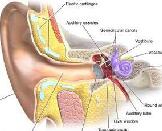Sensorineural Hearing Loss (SHL)
SNHL

Sensorineural hearing loss (SNHL) is a type of hearing loss, or deafness, in which the root cause lies in the inner ear or sensory organ or the vestibulocochlear nerve or neural part. SNHL accounts for about 90% of hearing loss reported. SNHL may occurs as a consequence of damaged or deficient cochlear hair cell function. The hair cells may be abnormal at birth, or damaged during the lifetime of an individual. There are both external causes of damage, like noise trauma and infection, and intrinsic abnormalities, like deafness genes.
Studies showed that the BALB/c mouse strain as an animal model for the study of progressive sensorineural hearing loss, mice ranging in age from young adult through middle age were studied. Aspirin-induced hearing loss as a model of sensorineural hearing loss is with sensorineural deafness, and there are large individual differences in the amount of temporary hearing loss induced by fixed doses of aspirin.
Organism species: Mus musculus (Mouse)
- Disease model DSI581Mu01 Mouse Model for Sensorineural Hearing Loss (SHL) In Stock
- Customized Service n/a Tissue of Sensorineural Hearing Loss (SHL) (If Necessary) Tissue Customized Service Offer
- Customized Service n/a Serums of Sensorineural Hearing Loss (SHL) (If Necessary) Serums Customized Service Offer
Organism species: Rattus norvegicus (Rat)
- Disease model DSI581Ra01 Rat Model for Sensorineural Hearing Loss (SHL) In Stock
- Customized Service n/a Tissue of Sensorineural Hearing Loss (SHL) (If Necessary) Tissue Customized Service Offer
- Customized Service n/a Serums of Sensorineural Hearing Loss (SHL) (If Necessary) Serums Customized Service Offer
Organism species: Cavia (Guinea pig )
- Disease model DSI581Gu01 Cavia Model for Sensorineural Hearing Loss (SHL) In Stock
- Customized Service n/a Tissue of Sensorineural Hearing Loss (SHL) (If Necessary) Tissue Customized Service Offer
- Customized Service n/a Serums of Sensorineural Hearing Loss (SHL) (If Necessary) Serums Customized Service Offer
Organism species: Oryctolagus cuniculus (Rabbit)
- Disease model DSI581Rb01 Rabbit Model for Sensorineural Hearing Loss (SHL) In Stock
- Customized Service n/a Tissue of Sensorineural Hearing Loss (SHL) (If Necessary) Tissue Customized Service Offer
- Customized Service n/a Serums of Sensorineural Hearing Loss (SHL) (If Necessary) Serums Customized Service Offer
Organism species: Canis familiaris; Canine (Dog)
- Disease model DSI581Ca01 Canine Model for Sensorineural Hearing Loss (SHL) In Stock
- Customized Service n/a Tissue of Sensorineural Hearing Loss (SHL) (If Necessary) Tissue Customized Service Offer
- Customized Service n/a Serums of Sensorineural Hearing Loss (SHL) (If Necessary) Serums Customized Service Offer


